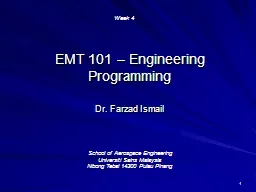

Engineering Programming Dr Farzad Ismail School of Aerospace Engineering Universiti Sains Malaysia Nibong Tebal 14300 Pulau Pinang Week 4 2 Bugs in code There are three types of bugs errors ID: 602543
Download Presentation The PPT/PDF document "1 EMT 101" is the property of its rightful owner. Permission is granted to download and print the materials on this web site for personal, non-commercial use only, and to display it on your personal computer provided you do not modify the materials and that you retain all copyright notices contained in the materials. By downloading content from our website, you accept the terms of this agreement.
Slide1
1
EMT 101 – Engineering Programming
Dr. Farzad Ismail
School of Aerospace EngineeringUniversiti Sains MalaysiaNibong Tebal 14300 Pulau Pinang
Week
4Slide2
2
Bugs in code
There are three types of bugs (errors)Syntax errors – violation of the grammatical rules of the programming language A compiler would detect syntax errors.
Semantic errors – violation of the ‘meaning’ or ‘action’ of the code – compiler does NOT detect and the code can runAlgorithm errors – most difficult to be detectedSlide3
3
Example: Syntax Error
int main () {
cout << “Hello world << endl; return 0; } Syntax Error: undeclared identifier “cout”Line 4 of program 1stprog.cpp Slide4
4
Example: Syntax Error
include <math>int main () {
int num; float value; double bigNum; bignum = num + value; } Can you detect the error?Slide5
5
Example: Semantic Error
char response; cout
<< “Please input (y)es or (n)o: ” << endl; cin >> response; while ( (response != ‘y’) || (response!= ‘n’) ) { cout << “Please try again. Enter (y)es or (n)o: ” << endl
;
}
The expression for while is always true regardless of what input you enter! Slide6
6
Discussion on semantic error example
If user enters ‘y’, the first part of the expression is false but the second part is true -> overall true due to OR.If user enters ‘n’, the first part is true but second part is false -> true
The program would keep on asking to try again regardless (infinite loop!)Corrected by (response != ‘y’) && (response!= ‘n’)Slide7
7
Example: Dangling if-else
if (condition 1) if (condition 2)
cout << “output: ” << endl; else cout << “neither” << endl;Correct version:if (condition 1) { if (condition 2)
cout
<< “output: ” <<
endl
;
}
else
cout
<< “neither” <<
endl
;
Slide8
8
Loops
We have discussed previously on control structures (if-else).Now we present another programming tool: Loops
Loops are used for iterative processesVery powerful tool in programmingSlide9
9
Loops
Do, while loopsFor loopsUsed to perform a repetitive (iterative) programming tasks
Usually over some array Slide10
10
Example: Finding the Total Kinetic Energy
Given a list of u and v velocity components, find the local KEAssume that u and v has n components
How would you use for loop to calculate each ‘local’ KE?Slide11
11
Example: Finding the Local Kinetic Energy
for (int i
=0; i < n; i++) { KE[i] = u[i]*u[i] + v[i]*v[i];
}
Slide12
12
Kinetic Energy Program
#include <iostream>
#include <string>#include <cmath>using namespace std; int main() { int n; double KE[n]; double u[n]; double v[n]; cout << “Enter number of particles: “ <<
endl
;
cin
>>n;
for (
int
i
=0;
i
<n;
i
++)
{
cout
<< “Enter the u velocity for particles: “ <<
endl
;
cin
>>u[
i
];
}
for (
int
i
=0;
i
<n;
i
++)
{
cout
<< “Enter the v velocity for particles: “ <<
endl
;
cin
>> v[
i
];
}
for (
int
i
=0;
i
<n;
i
++)
{
KE[
i
]= u[
i
]*u[
i
] + v[
i
]*v[
i
];
}
return 0;
} // end of program bodySlide13
13
Example: Finding the Total Kinetic Energy
Now that you know each local KE, how can you calculate the total (global) KE?for (int
i=0; i < n, i++) { KE[i] = u[i]*u[i] + v[i]*v[i];
}
double TKE = KE[0];
for (
int
i
=1;
i
< n,
i
++)
{
TKE = KE[
i
] + TKE;
}Slide14
14
Example: Finding the Total Kinetic Energy
Notice that you have two for loops of the same size using the same information. Can we be more efficient? double TKE = 0.0;
for (int i=0; i < n, i++) { KE[i] = u[i]*u[i] + v[i]*v[
i
];
TKE += KE[
i
];
}
Slide15
15
Exercises
Write a C++ program to solve an arbitrary matrix problem A= M*N where M and N are matrices in which you need to input the numbers on your screen.
Assume M and N has a size 3 x 3.Write a program to perform a numerical integration of f(x)=x^2*sin(x)*exp(x^2) over x=[0,Pi]. Use the simple rectangular area rule. Divide the domain into N subsections, where N=5,10,20,40. Compare your results.
Slide16
16
Take Home: Exercises
Write a C++ program to solve an arbitrary matrix problem A= M*N where M and N are matrices in which you need to input the numbers on your screen.
Now assume M and N has a size an arbitrary m x m size.Write a program to perform a numerical integration of f(x)=x^2*sin(x)*exp(x^2) over x=[0,Pi]. Use (
i
) the trapezoidal rule
(ii) the Simpson’s rule
Divide the domain into N subsections, where N=5,10,20,40. Compare your results
.
Slide17
17
Take Home: Exercises
Refer to Homework 2
in website.